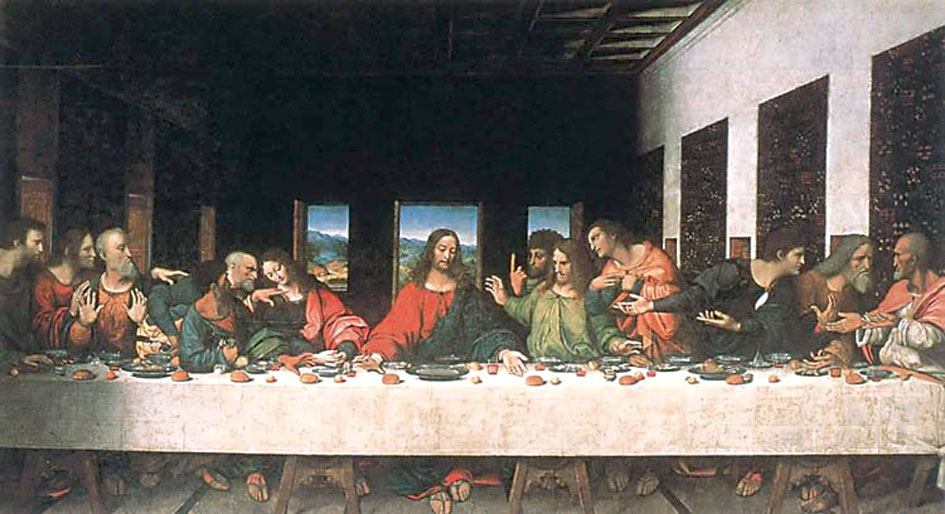
The Last Supper (1494-1498) by Leonardo da Vinci in the refectory of Santa Maria delle Grazie in Milan.
During the bitter-cold first week in February, I went to snow-bound Milan to write stories about an annual world-class food-and-wine event called “IdentitàGolose” and Milan University’s Library and Archive of Egyptology. With great good luck (because the obligatory reservations made online via www.milan-museum.com often have a two-month backlog), I was able to squeeze in a same-day visit, which lasts barely 15 minutes, to see Leonardo da Vinci’s masterpiece, The Last Supper, one of his 17 paintings and the only one not on canvas. I’d seen it only once before, almost 50 years ago. Just a month before Easter, I thought I’d share with ITV readers the unique way polymath Leonardo (1452-1519), a sculptor, architect, musician, draftsman, scientist, mathematician, engineer, anatomist, geologist, and cartographer, as well as painter, pictured this prelude to Our Savior’s sacrifice by telling this spellbinding mural’s story.
THE PAINTING
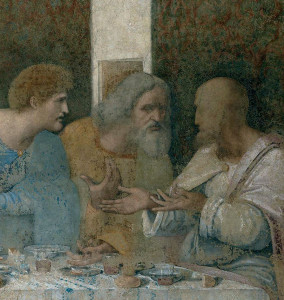
A self-portrait of Da Vinci depicted as the Apostle Jude Thaddeus
In 1482, Leonardo da Vinci, then 30, left Tuscany to be the court painter for Duke Ludovico Sforza (1451-1508) and his wife Duchess Beatrice d’Este (1475-1497) in Milan. A decade or so later, his patron commissioned Leonardo to paint The Last Supper as the centerpiece of his planned mausoleum in the monastery of the recently-completed Dominican Church of Santa Maria delle Grazie, which was later remodeled by Bramante, also the architect of St. Peter’s Basilica. Leonardo began work, which was supposed to take a year, in 1494, but did not complete the painting until 1498. According to Wikipedia’s article about Leonardo, “the novelist Matteo Bandello observed Leonardo at work and wrote that some days he would paint from dawn to dusk without stopping to eat and then not paint for three or four days at a time. This was beyond the comprehension of the prior of the convent, who hounded him until Leonardo
asked Ludovico to intervene. Vasari describes how Leonardo, troubled over his ability to depict the faces of Christ and Judas (Iscariot), told the Duke that he might be obliged to use the prior as his ‘model’ for Judas.”
It is generally believed that the white-bearded Apostle on the right of the painting, Jude Thaddeus, is the artist’s self-portrait.
Leonardo also probably cryptically “signed” this work; the knot at the end of the tablecloth’s right-hand edge represents the Latin word for knot, vincium.

An earlier version of the scene: The Last Supper by Ghirlandaio (1482). Located in Florence
LEONARDO’S CONCEPTION
The Last Supper theme was a traditional one for refectories, although this room wasn’t a refectory at the time Leonardo painted his masterpiece on the north wall. His work of art represents the Last Supper as told in the Gospel of John 13:21, when Jesus announces that one of his twelve Apostles would betray him before sunrise, but does not reveal which one. We know that Leonardo studied earlier paintings by Ghirlandaio and Andrea del Castagno with traditional iconography that focuses instead on the moment of the traitor’s identification, when Judas, who is represented in an isolated position with respect to the other Apostles, receives a piece of bread from Jesus and dips it in his dish. Leonardo, however, preferred the moment prior to this, dominated by doubt. His is the first version of this theme with the Apostles displaying the human emotions of doubt, shock, fear, and anger through the expressions on their faces, the movements of their hands, and their body language, which contrast with Jesus’ calmness. It should also be mentioned that the daylight and unbroken bread confirm that it is too early for Judas to have been identified as the traitor.
TECHNIQUE
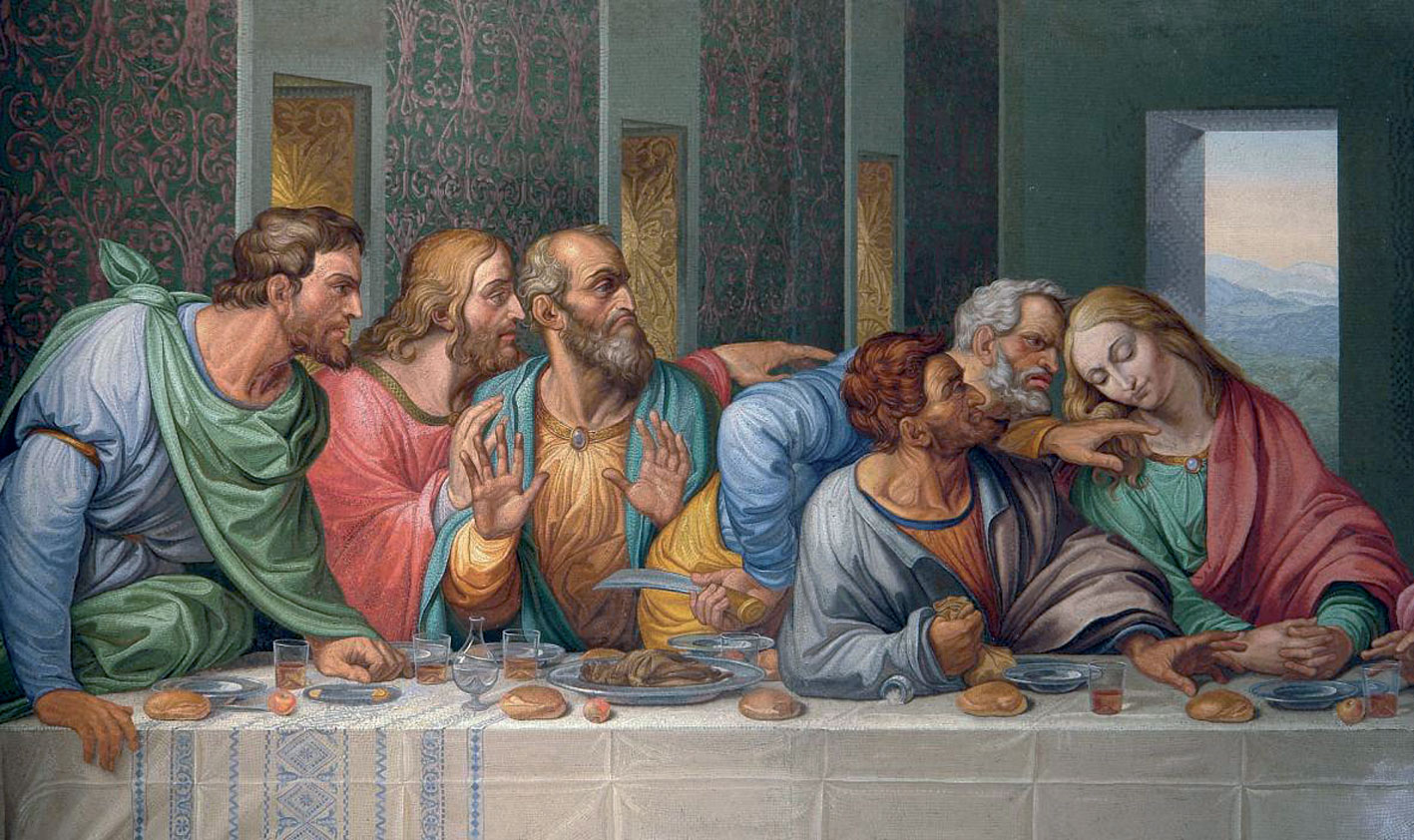
Giacomo Raffaelli’s life-size mosaic copy of Leonardo’s Last Supper (1809-14), now in Vienna’s Minoritenkirche
A wall panel in the entrance to the refectory explains: “Leonardo creates a sense of continuity between the actual space of the refectory and the painted space through an exceptional use of perspective, which has Christ’s right temple as its vanishing point; all the lines of perspective in the composition guide the viewer’s eye towards Jesus’ face, the narrative center of the work.” Leonardo’s early ideas, both notes and preparatory drawings, for this painting are illustrated in a sheet of figure studies, no. 12542r, conserved in the Royal Library at Windsor Castle.
Another first is that Leonardo’s Judas is not seated as is customary with his back to the viewer and, unlike the other well-lit Apostles, is in a shadow. He is also holding a purse. Although he would not yet have received the 30 silver coins, he was the treasurer for the Apostles. Until The Notebooks of Leonardo da Vinci were discovered during the 19th century, only Judas, Peter, John and Jesus could be positively identified.
The painting contains several references to the number 3 or the Blessed Trinity. The Apostles are seated in groups of three: to the left of Jesus (from the viewer’s point of view): Bartholomew, James the Lesser, and Andrew; Peter, Judas Iscariot, and John; to the right of Jesus: Thomas, James the Greater, and Philip; Matthew, Jude Thaddeus, and Simon the Zealot; there are three windows behind Jesus; and the shape of Jesus’ figure resembles a triangle.
MEDIUM
Also unique to The Last Supper is the medium Leonardo, always the inventor, used. According to Wikipedia, “he painted it on a dry wall rather than on wet plaster, so it is not a true fresco. Since a fresco cannot be modified as the artist works, Leonardo instead chose to seal the stone wall with a layer of pitch, gesso, and mastic, then paint onto the sealing layer with tempera.” Because of the method he used so that he, a known procrastinator with a marked tendency to leave projects unfinished, could make changes, his masterpiece began to deteriorate after a few years. The only evidence we have of what the original painting looked like is a 16th-century oil canvas by an unknown artist, in approximately original size, now housed in the Premonstratensian monastery, founded in 1128, at Tongerlo in Westerlo near Antwerp in Belgium. The copy reveals many details that are no longer visible in the original fresco, in particular the food, the room’s décor, and the landscape. Between 1809 and 1814 the Roman mosaic artist Giacomo Raffaelli made another life-size copy, commissioned by Napoleon and now in the Viennese Minoritenkirche.
DETERIORATION

The Last Supper by Dalí.
In 1517, Don Antonio de Beatis was the first to testify that Leonardo’s painting “is already beginning to be damaged.” Some 50 years later, in 1566, Leonardo’s biographer Giorgio Vasari wrote in his Lives: “Of the original by Leonardo (…) one can now perceive only a glaring stain.” A century later, the Dominican Fathers enlarged the door at the center of the wall that connected the refectory to the kitchen, which, although later bricked up, is still visible. It eliminated the part that depicted Christ’s feet, which, through early copies, were supposedly in a position symbolizing his forthcoming crucifixion. Further damage was done in 1768 when a curtain was hung over the painting to protect it; instead it trapped moisture on the surface, and whenever pulled back, scratched the flaking paint. In 1722, an English traveler testified that the rough wall was visible in various parts of the “fresco.” In 1799, when Napoleon’s troops turned the refectory into a stable and barn, the painting suffered still further vandalism. The soldiers passed their free time throwing stones at the painting and climbed ladders to scratch out the Apostles’ eyes. In 1812, the monastery of Santa Maria delle Grazie was used as a headquarters by the fire brigade and subsequently as a military barracks. In 1934, the refectory became a state museum, while the church and the cloisters were returned to the Dominicans. During the Second World War, on the night of August 15, 1943, a bomb struck the cloisters, causing the collapse of the refectory’s vault and its east wall. The Last Supper was saved from bomb splinters thanks to sandbags put in place at the start of the war. After a long period of “open air,” the collapsed parts of the refectory were rebuilt in 1947.
RESTORATION
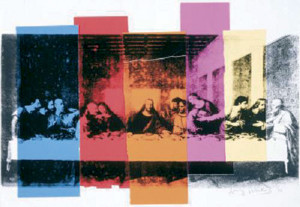
The Last Supper by Andy Warhol
A first restoration was attempted in 1726 by Michelangelo Bellotti, who filled in missing sections with oil paint and then varnished the whole mural; many others followed over the next two centuries. By the end of the 1970s the painting’s appearance had so badly deteriorated that, from 1978 to 1999, Pinin Brambilla Barcilon guided a major restoration project, which, in a sealed, climate-controlled ambience, undertook to stabilize the painting permanently and reverse the damage caused by dirt, pollution and the misguided 18th- and 19th- century restoration attempts. On May 28th, 1999, the painting was put back on display.
In 1980, UNESCO made the Santa Maria delle Grazie complex and The Last Supper a World Heritage site.
SPECULATIONS
Perhaps because of its deteriorated state, Leonardo’s Last Supper has been the target of much speculation by historians and writers, usually centered around purported hidden messages within the painting.
Several examples follow:
1) The Templar Revelation (1997) by Lynn Pickett and Clive Prince and The Da Vinci Code (2003) by Dan Brown both identify the person seated at Jesus’s right hand not as John the Apostle, but as a woman, and none other than Mary Magdalene, who supposedly bore Christ’s child after his death. It is true that the beardless John looks quite effeminate, but he was much younger than the other Apostles except for Phillip and maybe Matthew, both of whom are beardless here, too, while the others all have beards. Moreover, the Bible never mentions Mary Magdalene as present at the Last Supper, and if John is Mary, then where is John?
2) According to an article by Matthew Moore published on July 30, 2007 in The Telegraph, Slavisa Pesci, “an information technologist and amateur scholar,” superimposed Leonardo’s version of The Last Supper on its mirror image (with both images of Jesus lined up) and claimed that the resultant picture has a Templar Knight on the far left, a woman dressed in orange and holding a swaddled baby in her arms to the left of Jesus, and the Holy Grail in the form of a chalice in front of Jesus. With the naked eye no chalice is visible, although Jesus’ left hand is pointing to the Eucharist and his right to a glass of wine.
3) Giovanni Maria Pala, an Italian musician, has indicated that the positions of the hands and loaves of bread can be interpreted as notes on a musical staff, and, if read from right to left (because Leonardo was left-handed), form a musical composition.
4) Reported by British Vatican correspondent Richard Owen in an article entitled, “Da Vinci ‘predicted the world would end in 4066’ says Vatican researcher” in the London Times on March 15, 2010, is the most far-fetched of all theories. Sabrina Sforza Galitzia claimed to have deciphered the “mathematical and astrological” puzzle in Leonardo’s The Last Supper. She said that Leonardo foresaw the end of the world in a “universal flood” which would begin on March 21, 4006, and end on November 1 the same year. Leonardo believed that this would mark “a new start for humanity.”
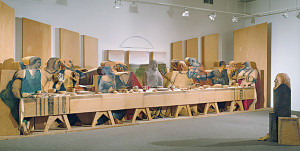
The Last Supper by Escobar.
Leonardo’s Last Supper is open all day Tuesday to Sunday from 8:15 AM to 7 PM with a maximum group of 25 people admitted every 15 minutes. Closed Mondays and on January 1st, May 1st, and Christmas Day. My same-day ticket, reserved by my hotel, cost 8 euros.
Epilogue: If you can’t make it to Milan, in Room VIII of the Pinocateca in the Vatican Museums there’s a Flemish tapestry of the Last Supper designed by Raphael, and in Raphael’s loggia on the second floor of the Apostolic Palace, one of the frescoes executed by Raphael’s workshop from 1517-19 is of the Last Supper. One of the frescoes on the northern wall of the Sistine Chapel, devoted to scenes from the life of Jesus and painted by Cosimo Rosselli (1431-1507) in 1481-2, also depicts the Last Supper.
There are several modern renditions of the Last Supper in the US. In 1955, Salvador Dalí painted The Sacrament of the Last Supper, one of the most popular paintings in the National Gallery of Art in Washington, DC. Sculptor Marisol Escobar was inspired by Leonardo’s Last Supper. Her work is in New York’s Metropolitan Museum of Art. And in 1986, Andy Warhol was commissioned to produce a series of paintings based on The Last Supper. They were first exhibited in a bank across the street from Santa Maria delle Grazie. This was Warhol’s last series of paintings before his death. On loan from the Andy Warhol Museum in his hometown of Pittsburgh, one of Warhol’s many paintings of The Last Supper (the Museum, at 117 Sandusky Street, owns three others) will take part in the traveling exhibition of 300 works “Andy Warhol: 15 Minutes Eternal” to commemorate the 25th anniversary of the artist’s death. The exhibition opened at the ArtScience Museum, Marina Bay Sands, in Singapore on March 17 and will travel to five other Asian cities: Hong Kong, Shanghai, Beijing, and Tokyo, over the next 27 months.




Facebook Comments